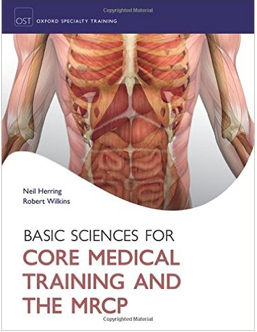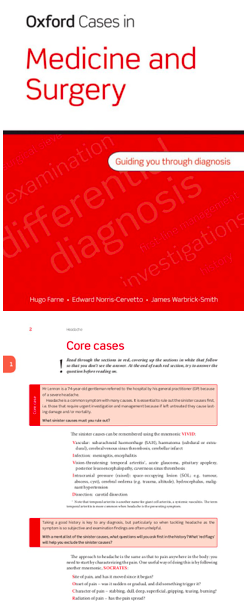Both Oxford Cases in Medicine and Surgery and Basic Science for Core Medical Training are newly published titles having come out just this past year. They promise to be useful additions to your medical textbook collection that contain essential knowledge for medical students transitioning from purely academic knowledge and needing to apply this knowledge clinically. Plus, they are concise and straight to the point, which means you learn what you need to be ready for a clinical environment and no heavy lifting.
Basic Sciences for Core Medical Training and the MRCP
Oxford University Press, Edited by Neil Herring and Robert Wilkins
Fresh off the Ox ford university press, comes a new textbook designed specifically, or so it seems, for the pre-clinical St Andrews student. Using the same systems-based approach, with integrated clinical relevance that our curriculum throws at us, this brand new book clearly lays out all the basic science necessary for the typical honors student. But how does the book really perform next to the average recommended medical booklist?
ford university press, comes a new textbook designed specifically, or so it seems, for the pre-clinical St Andrews student. Using the same systems-based approach, with integrated clinical relevance that our curriculum throws at us, this brand new book clearly lays out all the basic science necessary for the typical honors student. But how does the book really perform next to the average recommended medical booklist?
With plenty of information to cram into your head, and what seems like too few hours in a day, organisation is key in the life of a medical student. So the first thing you may notice about this book is how well it’s laid out. Covering all the major topics, from cell biology to endocrinology, the book moves logically through the systems and specialties, covering all the basic knowledge you could ask for, in as simple terms as possible.
If you’re an auditory learner, the clear layout of information, with bullet-pointed summaries will be the perfect resource for you… lists, tables and charts are used to summarise each chapter concisely into about 1 A4 page. However, there are plenty of illustrations too; well-labeled diagrams are scattered throughout. The one disappointment however is the lack of colour. It can be difficult to see the detail, particularly in the histological images (which are only coloured in black, white and purple), so honestly, I’d recommend looking elsewhere if you want to see some clear microscopic imagery. But then again, the book does make a fantastic information reference point to keep open next to you while you’re looking.
The flow chart summaries are particularly helpful when looking for a quick revision tool. Stuck up on your wall or on the back of your door, these illustrations work perfectly as memory prompters to test yourself, especially when it comes to the complicated, intertwining pathways of cardiac physiology.
System and subject specific testing is made easy, as each chapter ends with a set of practice MCQ’s. The questions have a familiar format; a pre-amble with a clinical scenario, some key basic science knowledge thrown in and then it’s time to diagnose or treat the patient. The only problem, is quite frankly, there aren’t enough of them! With only 10 MCQ’s at the end of each chapter, only a minuscule percentage of the content is actually touched upon in the questions.
In fact, this is the main drawback of the books entire content… there just isn’t enough. The “basic” knowledge really is what this book provides. The clear and concise information is really only the foundation of what is covered over the 3 pre-clinical years here in St Andrews. So although the perfect starting point for revision, don’t throw away that book list with delight… it’s clear that it’s only one resource of many, and for the real detail, you will need to supplement with additional resources.
Oxford Cases in Medicine and Surgery
Oxford University Press, Hugo Farne, Edward Norris-Cervetto, and James Warbrick-Smith
 Oxford Cases in Medicine and Surgery promises to be unique in that it’s goal is essentially to teach students how to think clinically without needing to be in a clinical setting. Different, but very common presenting complaints are the focus of each chapter, or ‘Core Case’ as they have been titled. Each Core Case begins by stating the name, age and presenting complaint of a patient and then, based solely on that information, asks you to think critically and identify all possible serious causes that you need to rule out first. Sound like something every medical student needs to know how to do when they get out on the wards? Definitely. However, instead of throwing you in the deep end filled with anxiety, as you would feel on a ward with an actual patient, Oxford Cases gives you mnemonics and walks you through all of the red flags you should be looking out for. This text teaches you how to evaluate patients’ presenting complaints in a systematic way that ensures you won’t be missing anything vital and are covering all possibilities efficiently.
Oxford Cases in Medicine and Surgery promises to be unique in that it’s goal is essentially to teach students how to think clinically without needing to be in a clinical setting. Different, but very common presenting complaints are the focus of each chapter, or ‘Core Case’ as they have been titled. Each Core Case begins by stating the name, age and presenting complaint of a patient and then, based solely on that information, asks you to think critically and identify all possible serious causes that you need to rule out first. Sound like something every medical student needs to know how to do when they get out on the wards? Definitely. However, instead of throwing you in the deep end filled with anxiety, as you would feel on a ward with an actual patient, Oxford Cases gives you mnemonics and walks you through all of the red flags you should be looking out for. This text teaches you how to evaluate patients’ presenting complaints in a systematic way that ensures you won’t be missing anything vital and are covering all possibilities efficiently.
In addition, each time you eliminate a possible cause in a core case, Oxford Cases pushes you further, continuously asking you why to broaden your understanding and getting you ready for the real thing. These informal questions scattered throughout the Core Case are supplemented by ‘Viva’ questions and SBAs (Single Best Answer questions) at the end of each chapter. The Viva questions are a set of questions meant to test your overall understanding of what was just taught in the Core Case in addition to some ethical dilemmas you may face. The SBAs are designed to have you master multiple-choice questions on your medical papers in no time.
Within each Core Case, ‘Short Cases’ are also presented which briefly explain another clinical case of a patient with the same presenting complaint, but ultimately has a different diagnosis. This, again, pushes you to think clinically and challenges you to draw from your previous academic knowledge and apply it. At the end of each ‘Short Cases’ section, Oxford Cases clearly site which research papers were used so, if you’re extra keen, you can easily find them to read more detailed information.

